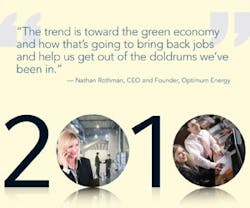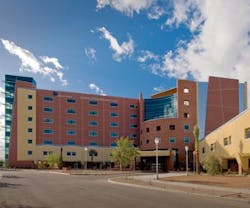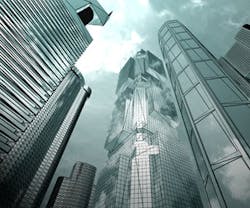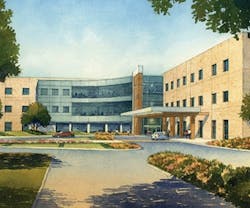Newsworthy
Trends: Green Building Systems and Products
With the stimulus package still providing funding for energy efficiency projects in 2010, and various clean energy and climate bills currently being debated in state legislatures and Congress, being green is no less important in 2010 than it was in the past. Nathan Rothman, CEO and founder of Optimum Energy, discusses current green trends.
Buildings: How can certain building systems – a more efficient HVAC system, for example – help a building owner save energy and reduce his/her building’s carbon footprint?
Rothman: [Efficient HVAC systems] can reduce energy use by 30 to 70 percent, and that reduces carbon footprint. You can look at the utility you purchase your energy from, and you can see what generation mix you have – coal, oil, nuclear, wind, etc. – and you can calculate the amount of carbon and greenhouse gases being reduced.
Buildings: How is legislation affecting the use of green products in commercial buildings?
Rothman: The current administration talks about the green economy, and the government plays an important role in that. You’ve got to have some kind of legislation that forces the issue, and the federal government is trying to do that. It just released a standard for federal buildings. The federal government is encouraging ESCO-type projects in federal buildings, and if there’s some overlying legislation by the states, cities, and feds, it will help.
Buildings: What are some green trends you’ve seen in the past year?
Rothman: Building owners want to reduce costs, and contractors want to get into the game of being green and being environmentally plugged in, so having an energy solution is something we see. Of course, we see manufacturers coming out with more green products, and wind farm and solar panels generating electricity.
The trend is toward the green economy and how that’s going to bring back jobs and help us get out of the doldrums we’ve been in.
Buildings: What are your predictions for green technology/systems in the next year?
Rothman: I think the green economy is driving it, so I think opportunities will increase this year. We’re working on a systemic view; we want to go from the chilled water plant or heating plant all the way out to the end user. That includes valves, air handlers, VAV boxes, and diffusers, and controlling all of that so the end user can determine what he/she wants in terms of HVAC – it’s about occupant comfort and not necessarily about the building.
We need to take care of occupants. For example, the HVAC system ought to be able to take care of people so they don’t have to run little heaters by their feet. That’s what we’re working on – total systemic change.
Sierra Club and USGBC Launch ‘Green Building for Cool Cities’
The USGBC and Sierra Club’s Cool Cities program announce the launch of the “Green Building for Cool Cities” collaboration. The partnership leverages Cool Cities’ 200 local campaigns and USGBC’s 80 chapters to encourage local governments to adopt policies supporting new and retrofitted energy-efficient buildings.
The organizations released a step-by-step green policy guide for communities of all sizes; recommended policies range from basic to advanced action plans to address energy efficiency and sustainability in the built environment.
The policies include leadership standards for government buildings that serve as models for the community, financial and no-cost incentives to build green, and improved minimum efficiency standards through energy code adoption and enforcement.
Banner Health Opens Doors to Cardon Children’s Medical Center
Banner Health’s Cardon Children’s Medical Center in Mesa, AZ, was designed to create an enduring and inspirational hospital experience for children of all ages.
Prior to the new facility, Banner Children’s Hospital was a “hospital with-in a hospital,” located within Banner Desert Medical Center. The new facility, designed by HDR Architecture, consolidates all pediatric care functions into one building and increases bed capacity. Construction costs for the $362 million facility were $250 million, which included the new hospital, remodeling sections of the existing space, and construction of the first two floors of a future tower.
The child-inspired design incorporates themes and “wow” factors throughout the hospital so children aren’t focused on their illnesses. Patients have “homes” instead of rooms, with doorways that look like those of homes. Room interiors are brightly colored and feature panoramic views of the surrounding communities and distant mountains. Positive distractions, such as playrooms with flat screen TVs, computers, and game consoles, were strategically placed throughout the facility.
New Building Controls Report Predicts Trends
A report from BCS Partners, which provides market analysis and research services for building automation and related technologies, has been released.
The report, titled BCS/2010: The Building Control Systems Market (2009-2014), is drawn from the authors’ more than 30 years of collective industry intelligence, details current conditions, and includes insight into:
- Projected North American market growth through 2014.
- Major economic and technological impacts.
- Trends in Web-based system monitoring and control.
- New focus on systems integration function.
- Emergence of wireless transmitters.
- Growing concerns about indoor air quality.
If you’re interested in learning more about this report, contact BCS Partners at [email protected] or 201-585-2050.
Second Guide in Sustainability ‘How-To Guide’ Series Available
Facility Engineering Associates and the IFMA Foundation released the second guide in the Sustainability “How-To Guide” Series.
The guide helps facility professionals understand how to maintain a successful energy management program. It highlights essential terms and explains monthly and annual energy consumption within buildings, and how this can change over time. Additionally, the guide equips readers with the latest trends and tools needed to tackle energy management, and it provides step-by-step assistance with the ENERGY STAR Portfolio Manager.
Need for Medical Space Likely to Grow
BremnerDuke Healthcare Real Estate predicts a significant increase in short- and long-term demand for medical offices and outpatient facilities.
Three trends will drive the growing demand:
- Anticipated healthcare reform will result in a greater percentage of the population having medical insurance, meaning that more individuals will seek regular medical attention.
- The increase in the aging population. During the past decade, office visits for 45- to 64-year-olds have increased by 7 percent. A greater number of insured people in this age group will elevate office visits by 12 percent.
- The movement toward treatment in an ambulatory care setting as opposed to emergency rooms. Proposed healthcare reform includes an allocation for prevention and wellness intervention, placing a stronger focus on primary care physicians.




